South Indian food has earned much fame across the globe, particularly for scrumptious dishes like Dosa, Vada, Idli, Uttapam and Sambar. South Indian meals comprise cuisines of five South Indian states namely Tamil Nadu, Karnataka, Kerala, Andhra Pradesh and Telangana, along with several local cuisines within these states. The region offers a wide variety of vegetarian and non-vegetarian dishes with each state holding its own uniqueness and food habits. Some authentic and popular South Indian dishes that are sure to delight taste buds include Chakra Pongal, Sambar and Vadai from Tamil Nadu; Rava Idli from Karnataka; Kadala Curry and Appam from Kerala; and Kebabs and Biryanis from Andhra Pradesh.
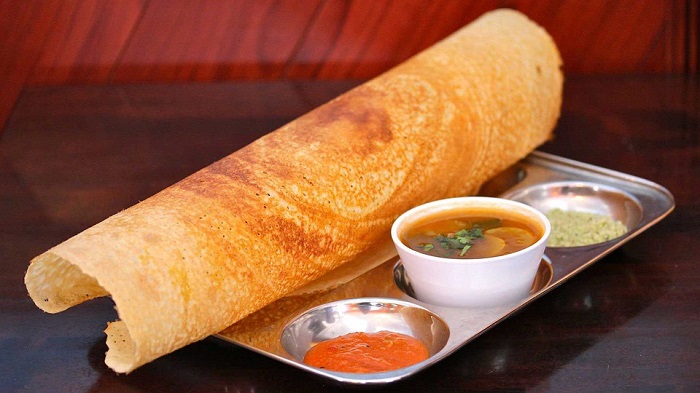
Image Source : Pixabay
Distinct Features
South India is known for its varied range of spices, many of which are being exported to different nations for centuries. The most important spices produced in South India are cinnamon, cardamom, nutmeg, cloves and pepper. The region is famous for a wide range of spicy foods with each state differing others predominantly from the spiciness of food, its different varieties and method of cooking. The staple food of locals of the region including some Brahmin communities is rice which is best savoured with Sambhar or curry.
Tampering of different South Indian dishes remains almost the same with primary ingredients being mustard seeds, red chillies, curry leaves and oil among others. Availability of different root tubers, coconut and huge variety of fish has witnessed use of such items in various regional dishes. Ingredients like chana dal, urad dal, plantain, tamarind, ginger, garlic, coconut and snake gourd along with fresh green chillies and dried red chillies are used extensively in preparing South Indian cuisines. Ragi (Eleusine coracana) also forms a staple diet in southern Karnataka while in northern Karnataka and Telangana, jowar (Sorghum) and bajra (Pearl millet) are consumed widely.
Let us have a glance at the various delicacies of different South Indian states to get the essence of each region.
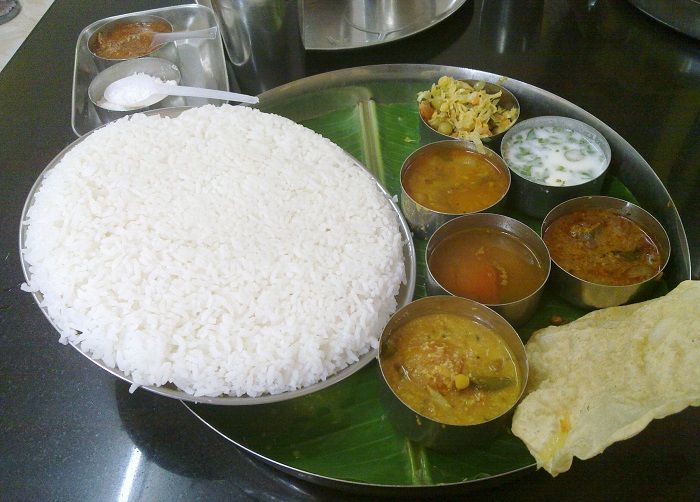
Cuisines from Tamil Nadu
The staple food of Tamil Nadu is rice which forms part of a typical Tamil meal and savoured with different mildly or richly spiced vegetarian and non-vegetarian dishes. Although most of the Tamilians barring the Brahmins and certain non-Brahmin communities are non-vegetarians, they usually consume vegetarian meals with meat intake being quite infrequent compared to other non-vegetarians across the globe.
The various Tamil dishes can be categorised in different groups starting from the regular meals, the light meals, snacks, desserts and different accompaniments.
Different Gravies and Curries
Traditionally, several dishes are served during the main meal that is typically savoured with rice as staple. These include:
- Sambar or sambhar, a very popular South Indian stew that is prepared with lentils, vegetables and tamarind.
- Rasam, a tamarind-based soupy dish prepared with tomato, cumin, pepper, chilli pepper and can also comprise of any combination of vegetables with lentils.
- Kuzhambu, a gravy dish made of toor dal, urad dal, tamarind and other spices that can include different vegetables.
- Thayir that is curd which when taken with rice is called ‘Thayir Sadam’ where Sadam means rice.
Each of these dishes has a number of varieties for instance under the category of rasam there are Kattu Saaru, Poondu Rasam, Koli Saaru, Inji Rasam and Kadalai Rasam among others while varieties of kuzhambu includes Mor Kuzhambu, Puli Kuzhambu and Molagu Kozhambu among others.
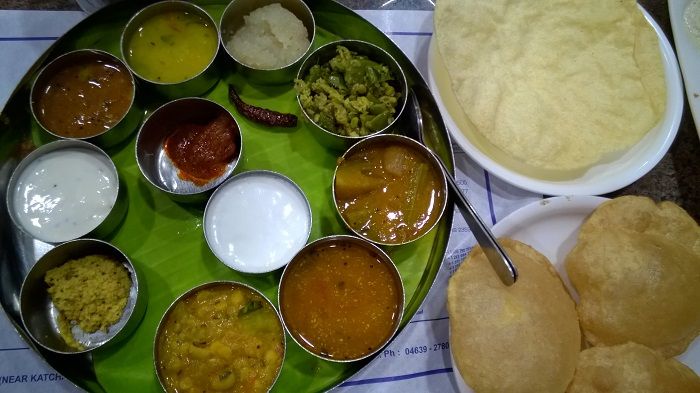
Side Dishes
These are basically accompaniments of the main meal which includes dishes like kootu, a semi-solid like preparation made of vegetables and lentils; poriyal, a fried or sautéed vegetable dish that usually forms a side dish of a three-course rice meal comprising of sambar, rasam and thayir; pappadam roundish and crispy appetizer made of dal or sago or potato either deep fried or roasted; and oorkai or pickles.
Sweet Dishes & Other Accompaniments
The sweet dishes served as the last course of a meal includes items like thirukannamidu, Kesari and kheer. After the meal bananas are offered to the guests followed with paan comprising of nicely folded betel leaves consisting of lime and betel nuts that is considered to have digestive value.
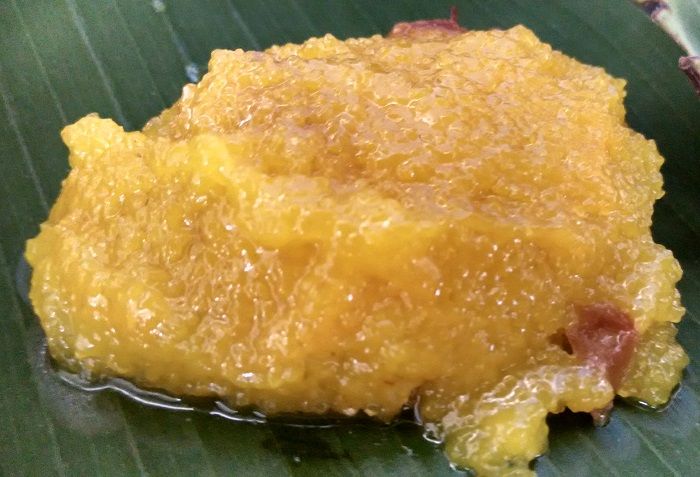
Image Source: Wikimedia.org
Light Meals
Light meals or tiffin items are taken during breakfast and early dinner and generally does not form part of the heavy mid-day meal. The most popular of them include:
- Dosa: a home-made pan cake prepared out of fermented rice and lentil batter and served hot with sambar and chutney. There are varied kinds of Dosas available either stuffed or plain that has garnered much fame as a South Indian delicacy.
- Idli: a South Indian steamed cake made out of fermented rice and black lentils (de-husked) that is savored with condiments like sambar and chutney.
- Upma: a thick porridge prepared with roasted suji (semolina) or coarse rice flour which may include different vegetables and seasonings.
- Parotta: a layered flatbread prepared with Maida flour, eggs, ghee/oil and served with vegetarian or non-vegetarian curry.
- Poori: unleavened deep-fried bread served with curry among others.
Snacks
Snacks items like vada, bhaji, and bonda are quite popular in this region and are relished with different varieties of chutneys and thayir Pachadi.
A mini Tamil veg meal may comprise of variety of rice preparations like tamarind rice, sambar rice and curd rice along with flat pan fried bread called chappathi complimented with a gravy dish, a Sweet Pongal and chips. A non-vegetarian meal includes biriyani, which can be of varied forms and non-vegetarian gravy items. A traditional South Indian meal is served on a banana leaf. Tamil cuisine conventionally proposes of including all the six tastes that any food can be categorised into, namely sweet, sour, salt, pungent, bitter and astringent into the main meal so as to get complete nutrition and balanced digestion. Traditionally there are two variants of Tamil food restaurants, the Brahmin restaurants that serve pure vegetarian food and the Military restaurant that serve vegetarian as well as non-vegetarian food, both of which welcome people from all caste, religion and communities. Tea and coffee are usually served as staple drinks in these restaurants.

Image Source: Wikimedia.org
Chettinad Food
Among the different regions of Tamil Nadu, cuisines of Chettinad, a region that falls in the Sivaganga district situated in southern part of the state, has earned huge fame for its spicy and aromatic dishes, particularly the non-vegetarian ones. The meaning of Chettinad itself is a social caste that is skilled in preparing food and the Chettinads are regarded as great chefs. The unique hot and pungent flavour of the dishes seasoned with grounded spices, the boiled egg toppings on the meals, the salted vegetables and sun-dried meat are some of the distinct features of this cuisine.
Some of the popular vegetarian dishes of the area include dosa, sambar, rasam, thayir sadam, paniyaram, kozhakattai and adikoozh. Different non-vegetarian dishes are made of chicken, mutton, crab, fish, prawn and lobster, some of the selected ones are fish fry, Chettinad pepper chicken and karuvattu kuzhambu.
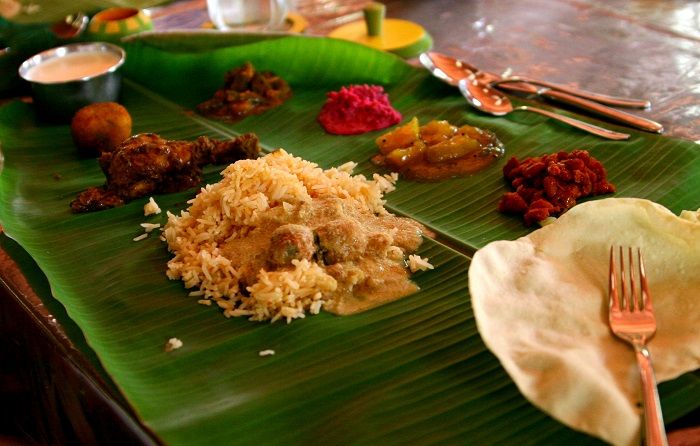
Karnataka Cuisine
The state of Karnataka offers a wide range of appetizing platters and boasts of some lip-smacking dishes such as Masala Dosa, Idli and Vada that originated in the temple streets of the city of Udupi. The dishes of the region are less spicy as compared to other South Indian states and contains liberal amount of palm sugar and jaggery with the exception of Northern Karnataka cuisine which is real hot.
The cuisines of the state vary according to different regions. Roti made of pearl millet and sorghum and rice are staple of North Karnataka cuisine which is usually taken with spiced and stewed lentils, spiced vegetable salads and eggplant dishes. Spicy condiments like pickles and chutneys are the common accompaniments of this cuisine which is famed for its spicy and hot nature. Seafood, coconut and coconut oil forms an integral part of coastal Karnataka cuisine. The gassi or gravy items prepared with chicken, meats and fish are taken with rice, the staple grain of the region. Preparations like Saaru, a dish like Rasam and Huli, a dish of vegetables and lentils made with different spices and coconut and then tempered with asafoetida, curry leaves and mustard are taken with rice. Side dishes like playa, accompaniments like gojju, tambli and happala forms part of the meal. Pork, meats and chicken are used to prepare a variety of Coorg cuisine that witnesses an extensive use of Kokum while rice remains the staple. Steamed rice and the nutritious Ragi Muddle made of ragi (finger millet) flour and water are the staples of old Mysore cuisine, also referred as South Karnataka cuisine. The usual South Karnataka dishes include saaru, uppinakai, huli, and gojju among others.
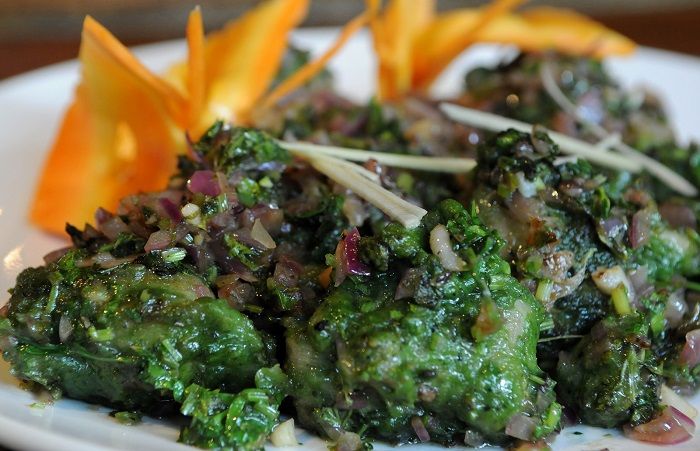
Dairy products are used in various forms. While yogurt forms an integral part of every meal that is taken with rice as the final course, spicy buttered milk is commonly served in hot summers. Ghee and butter are used to prepare various delicacies, especially during festivals and occasions.
A famous Karnataka dish is the Bisi Bele Bath which means hot lentil rice. As the name suggests this authentic dish that is served as the second course in traditional meals is made of rice, vegetables, toor dal, tamarind pulp and spices like curry leaves, asafoetida and nutmeg. It is often served with items like potato chips, papadum, salad, chutney and boondi.
The Karnataka cuisines are unfinished without the sweet course. The natives of the place are known for their knack for sweets. Some of the popular desserts of the state are coconut mithai, Mysore pak, Belagavi Kunda, dharwad pedha and rave unde. Interestingly most of these are non-dairy based desserts sweetened with jaggery and not refined sugar.
Udupi Hotels
Udupi hotels mostly serve Karnataka cuisine and have somewhat become synonymous with South Indian food. They have popularised this cuisine across India with their small set-ups. Generally vegetarian breakfast dishes like Dosa, Idli, Uttapam and Vada among others are served at affordable prices in these set-ups that are generally run by natives of Kanara region of Karnataka.
Kerala Cuisine
Kerala cuisine is varied, but best categorised according to the different local communities. The more famous ones are the Malabari Muslim dishes and the Syrian Christian dishes. Availability of coconut which is also the prime export item of the state has made it a fundamental component of Kerala cooking whether used as an ingredient or in oil form extracted from the nut. Availability of seafood in the coastal belt of the state makes it almost a daily consume. The common breakfast items include dosai, idli, porotta with mutton or chicken curry, vegetable stew, duck roast and chicken or mutton stew among various other dishes.
Different vegetarian dishes include aviyal, sambar, rasam, kichadi, pachady and olan to mention a few. There is a wide variety of non-vegetarian dishes with some of the popular ones being Malabari Fish Curry, Pork Mappas, Malabar Biriyani, Meen Thoran – a fish preparation with coconut, Duck Curry, Pork Vindallu, Shrimp Coconut Curry, Fish Fry and Fish Curry. The various snacks items are banana fry, cutlets, cakes, halwas and payasam among others.
Andhra Cuisine
Many of the exquisite and delectable cuisines of Andhra Pradesh indicate a profound influence of culinary styles of the Mughals on the cuisines of this place. The mouth-watering Andhra delicacies like Biryani, Kebabs and Kurmas among others that are usually heavy, spicy and hot in nature are sure to satiate the gastronomic enthusiasts. The traditional cuisines of Andhra are considered the spiciest among all other Indian cuisines and witness liberal use of tamarind and chilli powder that give the dishes a distinct tangy and hot flavour. Diverse ranges of cuisines are available in Andhra that differ mostly based on different regions. While the food of Rayalaseema district is quite similar to that of Tamil Nadu and eastern Karnataka due to its close proximity with these regions, the staple diet of the Telangana region, which has evolved into a new state, is rotis made of jowar and bajra. The Andhra costal region offers varied cuisines with unique flavour, courtesy the more fertile lands of the belt and also due to availability of variety of seafood.
The popular Andhra dishes include breakfast or tiffin items like:
- Upma, pulihora, attu and pesarattu
- Curries or kooralu like cabbage pesara pappu and gutti vankaya
- Pappu or dal/lentils like Moong Dal or Toor Dal prepared with vegetables
- Pulusu, varied form of sour curry-like stews made with tamarind paste
- Chaaru, a Rasam like preparation, however more diluted
- Different types of pickles like tomato pachadi, gongura pachadi and maaghaya.
- Some of the popular desserts are laddu, thokkudu laddu, boondi laddu, kaaja and pootarekulu.
Food of Andhra is never complete without mentioning the various delicacies that comes with a Mughal touch from the city of Hyderabad. Patronised by the Nizams, the Hyderabadi cuisines evolved as one of the most spiciest and delectable cuisines of India that has garnered worldwide fame. Some of the toothsome and finger-licking dishes include:
- Hyderabadi Biryani is made of Basmati rice, meat and selective rich spices.
- Other varieties of biryanis include Kachay Gosht ki Biryani and Dum ki Biryani.
- Achaari Subzi: a gravy preparation of vegetables having flavour of pickles
- Dum ka Murgh: a chicken preparation made in Hyderabadi Style
- Mirchi ka Salan: a chili and peanut curry that often accompanies the biryani
- Baghara Baingan: a brinjal curry that often forms a side dish with the Hyderabadi Biryani.



